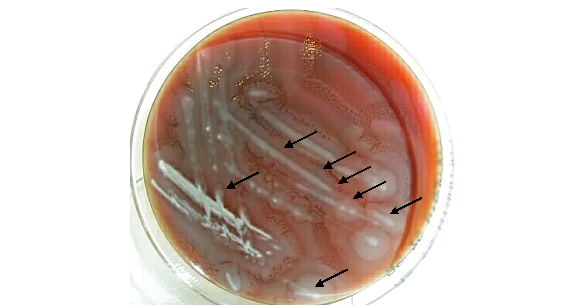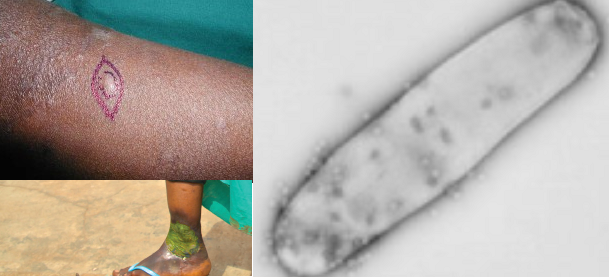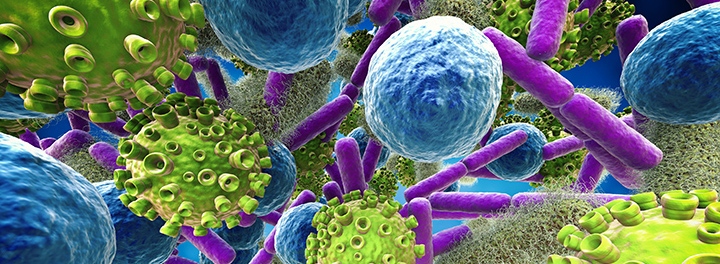Proteus mirabilis is a Gram-negative, motile, non-capsulated, facultative anaerobic, non-lactose fermenting and pleomorphic bacillus in the genus Proteus and family Enterobacteriaceae. P. mirabilis is mostly found in the environment (soil and water) and the human colon. Proteus species are common in slow-moving and still-freshwater habitats. They can also be found underneath floating leaves on streams. P. mirabilis is mostly implicated in urogenital tract infections in humans. The motility of P. mirabilis causes swarming on culture or agar plates, and this feature is characteristic of the organism and also aids in its identification in the laboratory.
PATHOGENESIS OF PROTEUS MIRABILIS INFECTION
P. mirabilis is a member of the intestinal flora; and it cause infections in humans when it leave the GIT to other parts of the body. Urinary tract infections (UTIs), bacteraemia, septicaemia wound infections, and pneumonia are some of the human infections associated or caused by P. mirabilis. It is occasionally implicated as a causative agent in community- and hospital-acquired UTI. Due to their rapid motility, P. mirabilis can invade the components of the urinary tract system (e.g. bladder and urethra) of its human host (both male and female) where it causes a UTI. P. mirabilis produces urease, and this leads to the production of alkaline urine. The production of urease by P. mirabilis aids in the pathogenesis of the organism.
Urease enzyme raises the pH of the urine by converting urea to ammonia (NH3), thus leading to the formation of kidney stones. Kidney stones or staghorn renal calculi block the normal flow of urine and causes several other bacterial infections due to urine retention in the urinary tract systems. The UTIs caused by P. mirabilis is usually indistinguishable from that caused by members of the Enterobacteriaceae family but the ability of the organism to swarm and produce urease can be used to differentiate it from other members of the coliform bacteria. The presence of a urine catheter can predispose an individual to an infection with P. mirabilis.
LABORATORY DIAGNOSIS OF PROTEUS MIRABILIS INFECTION
P. mirabilis is a rapidly motile and swarming bacterial species. On culture media (e.g. blood agar), P. mirabilis produces a typical swarming phenotype that covers the entire agar plate. This swarming phenotype of P. mirabilis can be physically observed as expanding waves or rings on the surface of the agar medium (Figure 1). Urine, sputum and pus are some of the specimen collected when P. mirabilis infection is suspected. P. mirabilis is culturable; and thus can be isolated on blood agar, MacConkey agar or eosin methylene blue (EMB) agar – where it produces non-lactose fermenting pale or colourless swarming colonies.
P. mirabilis swarms on blood agar plates and it produces a fish-like odour after aerobic incubation. Though swarming in Proteus species can be prevented or inhibited via the addition of certain chemicals to the culture media; this practice could inhibit the growth of other clinically important bacterial pathogens in the specimen being investigated. Biochemically, P. mirabilis is urease positive, indole negative, and it produces H2S on triple sugar iron agar (TSIA) slants. Other Proteus species are however positive to the indole test. On CLED, P. mirabilis does not swarm because the medium is deficient in electrolyte. Swarming in P. mirabilis is also inhibited on MacConkey agar plates because the media contain bile salts which discourage swarming.

TREATMENT
The treatment of P. mirabilis infection should be guided by a proper susceptibility test result to avoid the emergence of resistant strains. Cephalosporins, aminoglycosides, and ampicillin are some of the antibiotics that are active against P. mirabilis, and thus should be used for treatment.
PREVENTION AND CONTROL
UTI causedbyP. mirabilis can be prevented and brought under control by the removal of urinary catheter tubes from the affected patient; and this should be followed by antibiotic therapy.
OTHER SPECIES OF PROTEUS
- P. vulgaris:P. vulgaris inhabits the intestinal tracts of humans and animals; and it can be found in the soil, water, and feacal matter. P. vulgaris is an opportunistic pathogen of humans. It is known to cause wound infections. It infects the sinuses or respiratory tissues of the human body.
References
Brooks G.F., Butel J.S and Morse S.A (2004). Medical Microbiology, 23rd edition. McGraw Hill Publishers. USA. Pp. 248-260.
Madigan M.T., Martinko J.M., Dunlap P.V and Clark D.P (2009). Brock Biology of microorganisms. 12th edition. Pearson Benjamin Cummings Publishers. USA. Pp.795-796.
Prescott L.M., Harley J.P and Klein D.A (2005). Microbiology. 6th ed. McGraw Hill Publishers, USA. Pp. 296-299.
Ryan K, Ray C.G, Ahmed N, Drew W.L and Plorde J (2010). Sherris Medical Microbiology. Fifth edition. McGraw-Hill Publishers, USA.
Singleton P and Sainsbury D (1995). Dictionary of microbiology and molecular biology, 3rd ed. New York: John Wiley and Sons.
Talaro, Kathleen P (2005). Foundations in Microbiology. 5th edition. McGraw-Hill Companies Inc., New York, USA.
Discover more from Microbiology Class
Subscribe to get the latest posts sent to your email.




